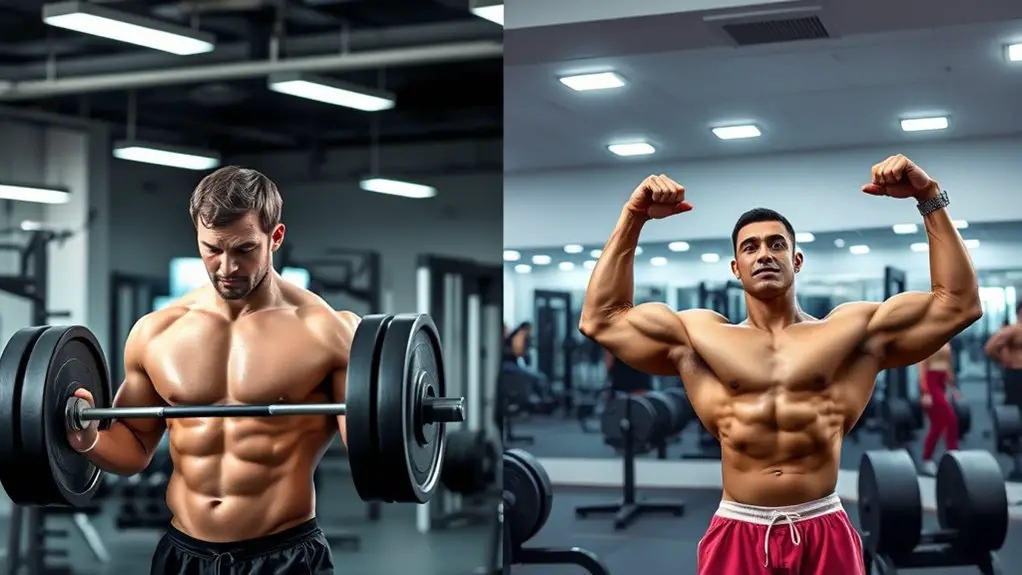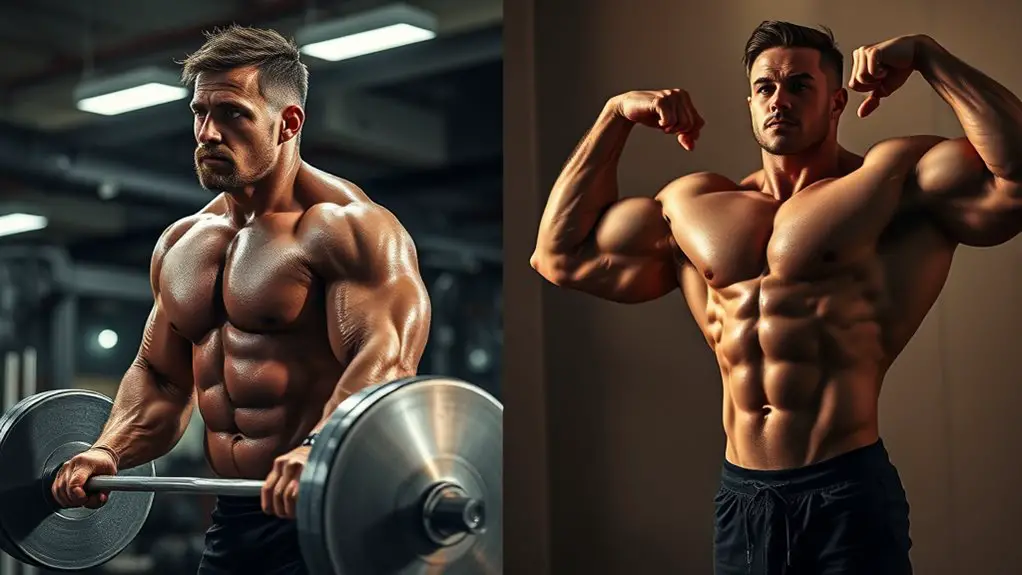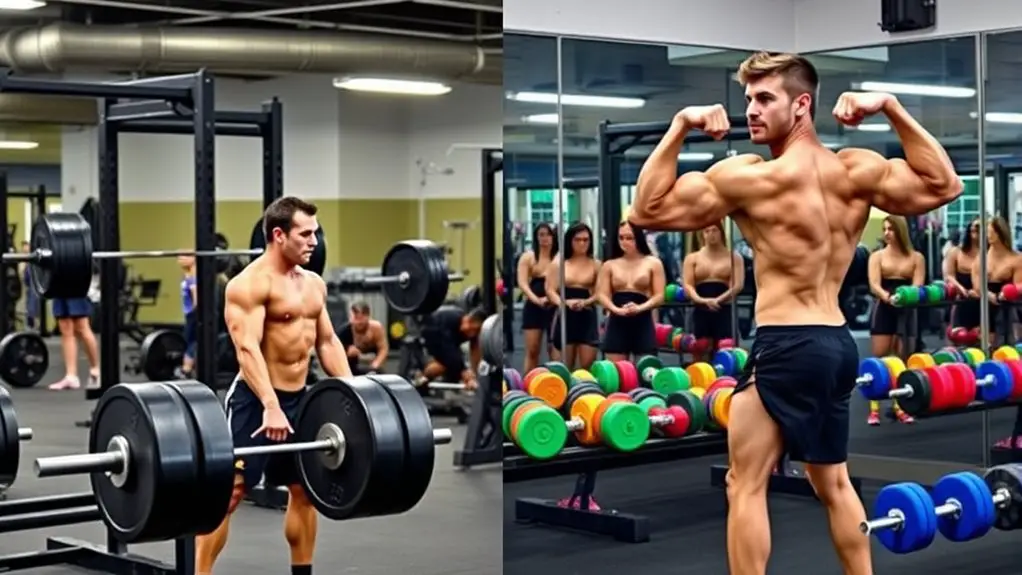The Differences Between Strength Training and Bodybuilding

Strength training focuses on improving functional strength and overall performance, while bodybuilding aims for muscle hypertrophy and aesthetic appeal. In strength training, you’ll lift heavier weights with fewer repetitions and use compound movements. Bodybuilding involves higher reps and isolation exercises designed for muscle shaping. Nutritionally, strength training emphasizes carbs for energy, whereas bodybuilding prioritizes protein for growth. Both paths offer unique benefits, so explore how these disciplines can align with your personal fitness goals for even better results.
Defining Strength Training

When you think about strength training, it’s important to recognize that it focuses on enhancing your overall strength and power, rather than just building muscle size. Many people fall for strength training misconceptions, believing it’s solely for athletes or bodybuilders. In reality, anyone can reap the strength training benefits, regardless of age or fitness level.
Strength training improves muscle function, boosts metabolism, and enhances bone density, making it essential for long-term health. It also contributes to better posture and balance, which can reduce injury risk. You don’t need to lift heavy weights to experience these advantages; even bodyweight exercises can be effective.
Defining Bodybuilding
Bodybuilding is an intricate art that revolves around sculpting the body through targeted training and nutrition. It’s more than just lifting weights; it’s about creating a physique that emphasizes symmetry, proportion, and aesthetics. The rich bodybuilding history dates back to the late 19th century, when figures like Eugen Sandow popularized the sport. Today, bodybuilding competitions showcase these meticulously crafted bodies, where athletes are judged on various criteria, including muscle mass, definition, and stage presence.
To excel in bodybuilding, you’ll need a well-structured workout plan, a balanced diet, and a deep understanding of your body’s needs. You’ll spend countless hours in the gym, perfecting your form and technique, all while gearing up for the next competition. Ultimately, bodybuilding challenges you to push your limits, setting you on a transformative journey toward achieving your ideal physique.
Primary Goals and Objectives

Although many people might view strength training and bodybuilding as similar pursuits, their primary goals and objectives differ markedly. Strength training focuses on improving your overall strength and functional ability. Your strength goals may include increasing the amount of weight you can lift or enhancing your performance in sports. On the other hand, bodybuilding is primarily about achieving muscle hypertrophy, which means maximizing muscle size and definition for aesthetic purposes.
Here’s a quick comparison of the two:
| Aspect | Strength Training |
|---|---|
| Primary Focus | Strength goals |
| Training Style | Lower reps, higher weight |
| Muscle Definition | Less emphasis |
| Goal Outcome | Functional strength |
| Typical Athletes | Powerlifters, athletes |
Understanding these goals will help you determine which approach aligns with your fitness aspirations. Whether you aim for pure strength or aesthetic appeal, both paths offer unique benefits.
Training Techniques and Methods
When it comes to training techniques and methods, understanding the differences in workout styles can really help you tailor your approach. You’ll want to contemplate various repetition schemes and how they affect your strength or muscle growth goals. Plus, knowing the equipment preferences for each style can make a significant difference in your training effectiveness.
Workout Styles Comparison
While both strength training and bodybuilding aim to enhance physical fitness, they adopt different approaches to achieve their goals. Strength training focuses on increasing workout intensity, primarily through heavier weights and lower repetitions. You’ll typically see compound movements like squats and deadlifts, which target multiple muscle groups for functional strength. On the other hand, bodybuilding emphasizes exercise variety, incorporating numerous isolation movements to sculpt and define individual muscles. You’ll often perform higher repetitions with moderate weights, promoting muscle hypertrophy. This difference in focus means that strength training is about performance and power, while bodybuilding hones in on aesthetics. Understanding these workout styles can help you choose a path that aligns with your fitness objectives.
Repetition Schemes Explained
Understanding how repetition schemes work is essential for tailoring your training to meet specific goals, whether you’re aiming for strength or muscle growth. In strength training, you’ll typically work within lower repetition ranges, often between 1 to 6 reps, using higher intensity levels. This approach focuses on maximizing your strength output and improving your performance. On the other hand, bodybuilding emphasizes higher repetition ranges, usually from 8 to 12 reps or more, with moderate intensity levels. This method promotes hypertrophy, leading to increased muscle size. By adjusting your repetition schemes, you can effectively target your training outcomes, ensuring you’re not just lifting weights but also lifting your fitness game to new heights.
Equipment Preferences Noted
Though both strength training and bodybuilding share the goal of building muscle, the equipment preferences can differ considerably based on your specific objectives. If you’re focused on increasing overall strength, you might lean towards barbell preferences, incorporating compound lifts like squats and deadlifts. This approach allows for greater weight progression and functional strength gains.
On the other hand, if your aim is hypertrophy and muscle definition, machine usage often takes precedence. Machines provide controlled movements, which can help target specific muscle groups while minimizing injury risk. Ultimately, your choice of equipment should align with your goals, whether that’s maximizing strength or sculpting your physique. Understanding these preferences helps you tailor your workouts effectively.
Nutritional Approaches
When it comes to fueling your workouts, understanding nutritional approaches is key. You’ll want to contemplate macronutrient ratios, meal timing strategies, and how supplementation can differ based on whether you’re strength training or bodybuilding. Each approach can greatly impact your performance and results, so let’s break them down.
Macronutrient Ratios
While both strength training and bodybuilding emphasize physical development, their nutritional approaches, particularly macronutrient ratios, can differ markedly. For strength training, the focus is often on optimizing performance and recovery, leading to a higher protein distribution to support muscle repair. Bodybuilders, on the other hand, prioritize aesthetics, which might require a more calculated calorie balance and specific macronutrient ratios to reduce body fat while maintaining muscle.
Here are some key differences in macronutrient focuses:
- Strength training may emphasize higher carbs for energy.
- Bodybuilding typically requires higher protein intake for muscle growth.
- Fats are essential for hormone regulation in both but may vary in proportion.
- Overall calorie intake will differ based on goals—performance vs. appearance.
Meal Timing Strategies
Meal timing strategies play an essential role in maximizing the benefits of both strength training and bodybuilding, as they can greatly influence energy levels and recovery. For ideal performance, focus on your pre workout nutrition. Consuming a balanced meal or snack rich in carbs and protein about 30-60 minutes before your workout can boost your energy and enhance your performance.
After your session, prioritize post workout recovery by eating within an hour. This meal should also be protein-rich to help repair muscles and replenish glycogen stores. Timing your meals around workouts not only aids in energy management but also supports muscle growth and recovery, allowing you to achieve your fitness goals more effectively.
Supplementation Differences
Although the goals of strength training and bodybuilding may overlap, their supplementation strategies often differ greatly. Strength trainers typically focus on performance enhancers like creatine usage and pre workout supplements to boost strength and power. In contrast, bodybuilders often prioritize protein powders and amino acids to promote muscle growth and recovery.
Here are some key differences in supplementation approaches:
- Strength Trainers: Emphasize creatine and performance enhancers for explosive power.
- Bodybuilders: Rely on protein powders and amino acids for muscle hypertrophy.
- Recovery Focus: Bodybuilders may use post workout recovery supplements more consistently.
- Vitamin Supplementation: Both may incorporate natural supplements for overall health, but bodybuilders often emphasize this more for aesthetic goals.
Understanding these differences can help you tailor your supplementation to your specific goals.
Outcomes and Benefits
When you plunge into strength training or bodybuilding, you’ll discover distinct outcomes and benefits that cater to various fitness goals. Strength training primarily focuses on performance enhancement, helping you lift heavier weights and improve overall athletic ability. You’ll notice better functional strength, which translates into everyday activities and sports performance.
On the other hand, bodybuilding emphasizes muscle growth, sculpting your physique and increasing muscle mass. If your goal is to achieve a particular aesthetic, bodybuilding routines target specific muscle groups for size and definition.
Both disciplines can enhance your health by boosting metabolism, reducing body fat, and improving bone density. Additionally, incorporating cardio exercises like skipping rope into your routine can further aid in reducing body fat and improving overall fitness levels. You’ll also experience increased confidence as you see progress over time. Ultimately, whether you choose strength training or bodybuilding, both paths contribute to a healthier, stronger you, each with unique advantages tailored to your aspirations.
Frequently Asked Questions
Can Beginners Start With Strength Training or Bodybuilding?
Why not start with strength training or bodybuilding? As a beginner, it’s all about your workout preferences. Focus on beginner techniques, and you’ll build a solid foundation while discovering what you enjoy most in fitness.
How Do Injuries Differ Between Strength Training and Bodybuilding?
Injuries in strength training often stem from overexertion, while bodybuilding injuries usually arise from repetitive motions. You should focus on injury prevention techniques and effective recovery strategies to minimize risks in either approach.
Is One Approach Better for Weight Loss?
Isn’t everyone looking for the best way to shed pounds? For weight loss, combining strength training and cardio can enhance fat burning. Each method has its benefits, so find what keeps you motivated and consistent!
Can Women Participate in Both Strength Training and Bodybuilding?
Absolutely, you can participate in both! Female empowerment in fitness shatters misconceptions that women shouldn’t lift heavy. Embrace strength training and bodybuilding for a stronger, more confident you, while enjoying diverse workout benefits tailored to your goals.
How Often Should I Switch Between Strength Training and Bodybuilding?
You should switch between strength training and bodybuilding based on your program duration and training goals. Generally, every 6-8 weeks works well, allowing you to adapt and avoid plateaus while keeping your workouts fresh and effective.





